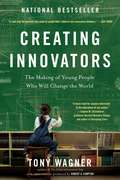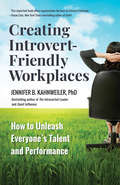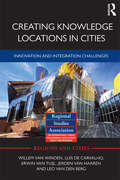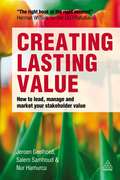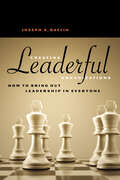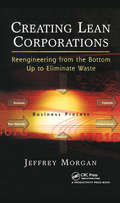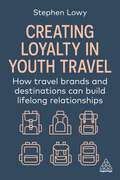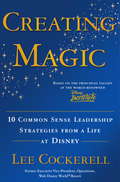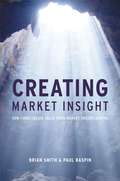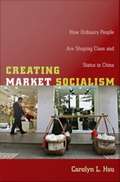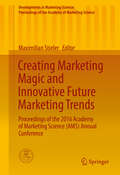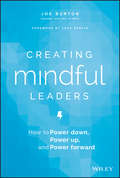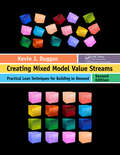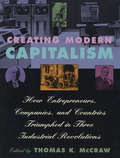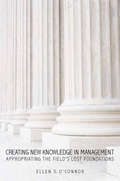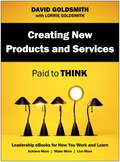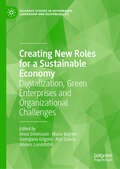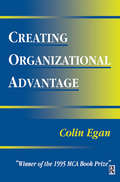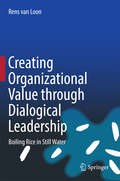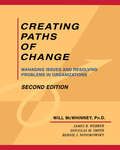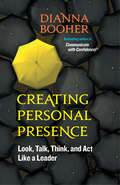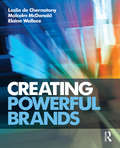- Table View
- List View
Creating Innovators
by Tony WagnerFrom a prominent educator, author, and founder of Harvard's Change Leadership Group comes a provocative look at why innovation is today's most essential real-world skill and what young people need from parents, teachers, and employers to become the innovators of America's future.In this groundbreaking book, education expert Tony Wagner provides a powerful rationale for developing an innovation-driven economy. He explores what parents, teachers, and employers must do to develop the capacities of young people to become innovators. In profiling compelling young American innovators such as Kirk Phelps, product manager for Apple's first iPhone, and Jodie Wu, who founded a company that builds bicycle-powered maize shellers in Tanzania, Wagner reveals how the adults in their lives nurtured their creativity and sparked their imaginations, while teaching them to learn from failures and persevere. Wagner identifies a pattern--a childhood of creative play leads to deep-seated interests, which in adolescence and adulthood blossom into a deeper purpose for career and life goals. Play, passion, and purpose: These are the forces that drive young innovators. Wagner shows how we can apply this knowledge as educators and what parents can do to compensate for poor schooling. He takes readers into the most forward-thinking schools, colleges, and workplaces in the country, where teachers and employers are developing cultures of innovation based on collaboration, interdisciplinary problem-solving, and intrinsic motivation. The result is a timely, provocative, and inspiring manifesto that will change how we look at our schools and workplaces, and provide us with a road map for creating the change makers of tomorrow. Creating Innovators will feature its own innovative elements: more than sixty original videos that expand on key ideas in the book through interviews with young innovators, teachers, writers, CEOs, and entrepreneurs, including Thomas Friedman, Dean Kamen, and Annmarie Neal. Produced by filmmaker Robert A. Compton, the videos are accessible via links and QR codes placed throughout the eBook text or by visiting www.creatinginnovators.com.
Creating Introvert-Friendly Workplaces: How to Unleash Everyone’s Talent and Performance
by Jennifer Kahnweiler"This important book offers organizations the keys to introvert inclusion."—Susan Cain, New York Times bestselling author of Quiet InfluenceThe first guide to creating a welcoming culture that maximizes the powerful contributions introverts bring to the workplace.As the diversity, equity, and inclusion wave widens and deepens its reach, introversion is becoming a natural part of that movement. After all, about half the population identify as introverts, but many organizations are stuck in traditional extrovert-centric workplace cultures that reward people for speaking up publicly, expect them to log face time, and employ hiring and promotion practices rooted in the past. This ultimately discourages introverts from contributing and reaching their full talent potential, which could have a major impact on the bottom line."Champion for introverts" Jennifer Kahnweiler offers a road map for everyone in the workplace--including leaders, human resource managers, and team members--to create inclusive, introvert-friendly cultures. Kahnweiler provides an assessment to determine how introvert friendly your organization is and looks at every aspect of organizational life--hiring, training, leading, communicating, meeting, designing workplaces, and more--through an inclusive lens. You'll discover how to make open-space offices introvert friendly, what the best practices are for encouraging introverts to participate on teams, which training techniques work best for introverts, and how to make remote positions work.
Creating Knowledge Locations in Cities: Innovation and Integration Challenges (Regions And Cities Ser. #54)
by Willem van Winden Luis de Carvalho Erwin van Tuijl Jeroen van Haaren Leo van den BergBased on a clear and comprehensive literature review, this book contains an analysis of five knowledge locations in Europe and one in South Korea. The case studies in the book cover several European countries (Ireland, Finland, Germany, Spain, The Netherlands). The cases are well grounded in the different contexts that these national settings provide, which allows comparisons between them.
Creating Lasting Value
by Jeroen Geelhoed Salem Samhoud Ingrid SmoldersThe consequences of a primary focus on shareholders over the last few decades has emphasized that that a new model of value creation is necessary. Today's economy demands organizations that create value, not only for shareholders but also for customers, employees, leaders and society. Businesses that face up to this challenge by focusing on all the stakeholders involved will be far more successful in the long term than those driven purely by seeking to deliver the maximum return on shareholder investment. Creating Lasting Value shows readers how to achieve lasting results by channeling efforts into three key areas. It demonstrates how to lead the value, manage the value, and market the value. The successful organizations of the future will be those that can put these principles into practice: this book shows you how.
Creating Leaderful Organizations: How to Bring Out Leadership in Everyone
by Joseph A. RaelinThe times demand a new style of leadership. Employees today are highly trained and independent-they can offer much more to an enterprise than simply their obedience. And with the relationship between worker and organization constantly changing, no one person will likely be able to lead alone. Creating Leaderful Organizations presents a paradigm of leadership tailored to our times, one that is based on mutual-rather than heroic-leadership. It is not merely consultative, with leaders graciously allowing followers to participate in leadership, nor is it a stewardship approach in which the leader occasionally steps aside to allow others to take over temporarily. It is a revolutionary new approach that transforms leadership from an individual property to a collective responsibility. Raelin details how "leaderful" practice can accomplish the critical processes of leadership more effectively than any existing approach. And using actual examples from leading-edge organizations, he offers practical guidance for assessing your own and others' leaderful predisposition, preparing for leaderful practice, distributing leadership roles, and dealing with resistance to change.
Creating Lean Corporations: Reengineering from the Bottom Up to Eliminate Waste
by Jeffrey MorganCreating Lean Corporations utilizes a bottom-up approach in which the employees who perform tasks are empowered to create and manage their own portions of the business process. Each task is defined using a task model that indicates the input-output relationships between tasks. This approach is essential for creating and improving business processes that are large and complex. This lean approach was successfully applied at a major automotive manufacturing company and was awarded the Charles F. Boss Kettering Award for technological innovation in 2000. This book is for business process managers (especially lean leaders) who seek to reengineer their business processes using lean principles.
Creating Loyalty in Youth Travel: How Travel Brands and Destinations Can Build Lifelong Relationships
by Stephen LowyBy attracting young people, travel brands and destinations can create a lifetime of value, with young people often staying longer, spreading their spend across a destination, contributing to the local economy and returning again and again. Creating Loyalty in Youth Travel explores the varying and unique needs of young tourists - from backpackers to youth mobility workers - and the challenges brands and destinations face in attracting and retaining them. While travel professionals often target certain sectors such as business or luxury travellers, this can be a short-sighted strategy. Youth travellers can be a more sustainable market as they frequently form an emotional tie to a destination or travel brand, driving them to return throughout their lives, sharing with family and friends and increasing their spend as they age. This book looks at how successful brands and destinations prioritize developing long-term relationships with travellers early on, so that they can continue to cater to loyal customers throughout their lives with different offerings from within the same brand. Some countries and travel brands excel at this, building it into the heart of their strategy, while others have ignored this key market to their own detriment. Through extended interviews from leaders in the sector such as Marriott and Tourism Australia, this book helps tourism and hospitality professionals to understand the needs of the youth traveler market and harness the potential of it to build a long-term strategy for the tourism industry.
Creating Magic: 10 Common Sense Leadership Strategies from a Life at Disney
by Lee CockerellThe secret for creating “magic” in our careers, our organizations, and our lives is simple: outstanding leadership—the kind that inspires employees, delights customers, and achieves extraordinary business results. No one knows more about this kind of leadership than Lee Cockerell, the man who ran Walt Disney World® Resort operations for over a decade. And in Creating Magic, he shares the leadership principles that not only guided his own journey from a poor farm boy in Oklahoma to the head of operations for a multibillion dollar enterprise, but that also soon came to form the cultural bedrock of the world’s number one vacation destination. But as Lee demonstrates, great leadership isn’t about mastering impossibly complex management theories. We can all become outstanding leaders by following the ten practical, common sense strategies outlined in this remarkable book. As straightforward as they are profound, these leadership lessons include:- Everyone is important.- Make your people your brand. - Burn the free fuel: appreciation, recognition, and encouragement. - Give people a purpose, not just a job.Combining surprising business wisdom with insightful and entertaining stories from Lee’s four decades on the front lines of some of the world’s best-run companies, Creating Magic shows all of us—from small business owners to managers at every level—how to become better leaders by infusing quality, character, courage, enthusiasm, and integrity into our workplace and into our lives.“It’s not the magic that makes it work; it’s the way we work that makes it magic.”
Creating Market Insight
by Brian Smith Paul Raspin"Brian Smith and Paul Raspin demonstrate a thorough and pragmatic approach to creating and applying sound market insight. Using numerous practical examples, learning points and provocative takeaways, they build on established strategic marketing principles to give you actionable knowledge you can apply your business to create lasting market advantage."Beverley Dipper, Market Insight Manager, Microsoft UK Ltd"I have no hesitation in saying buy this book. It will find a front and centre position in your bookshelf, with plenty of post-its marking pages that you will return to again and again."Mark Irvine, Strategy Manager, De Beers Diamond Trading Company"A readable and well-founded description of how to generate actionable customer insight and follow it through with passionate and consistent execution"Dag Larsson Global Brand Insight Director, AstraZenecaCreating Market Insight addresses the key strategic issue facing any company: How do we make sense of our market and find those precious nuggets of knowledge that lead to real competitive advantage?Creating Market Insight:Explains how firms tailor their market scanning behaviour to work well in the special conditions of their marketDescribes the process through which data is translated first into information, and then knowledgeDifferentiates routine market knowledge from true insight and details how firms turn insight into valueProvides a detailed, step-by-step process that enables the reader to emulate the success of insightful firmsCreating Market Insight is written for managers who need to need to create value in the real world.
Creating Market Socialism: How Ordinary People are Shaping Class and Status in China
by Carolyn L. HsuIn the midst of China's post-Mao market reforms, the old status hierarchy is collapsing. Who will determine what will take its place? In Creating Market Socialism, the sociologist Carolyn L. Hsu demonstrates the central role of ordinary people--rather than state or market elites--in creating new institutions for determining status in China. Hsu explores the emerging hierarchy, which is based on the concept of suzhi, or quality. In suzhi ideology, human capital and educational credentials are the most important measures of status and class position. Hsu reveals how, through their words and actions, ordinary citizens decide what jobs or roles within society mark individuals with suzhi, designating them "quality people. " Hsu's ethnographic research, conducted in the city of Harbin in northwestern China, included participant observation at twenty workplaces and interviews with working adults from a range of professions. By analyzing the shared stories about status and class, jobs and careers, and aspirations and hopes that circulate among Harbiners from all walks of life, Hsu reveals the logic underlying the emerging stratification system. In the post-socialist era, Harbiners must confront a fast-changing and bewildering institutional landscape. Their collective narratives serve to create meaning and order in the midst of this confusion. Harbiners collectively agree that "intellectuals" (scientists, educators, and professionals) are the most respected within the new social order, because they contribute the most to Chinese society, whether that contribution is understood in terms of traditional morality, socialist service, or technological and economic progress. Harbiners understand human capital as an accurate measure of a person's status. Their collective narratives about suzhi shape their career choices, judgments, and child-rearing practices, and therefore the new practices and institutions developing in post-socialist China.
Creating Marketing Magic and Innovative Future Marketing Trends: Proceedings of the 2016 Academy of Marketing Science (AMS) Annual Conference (Developments in Marketing Science: Proceedings of the Academy of Marketing Science)
by Maximilian StielerThis volume includes the full proceedings from the 2016 Academy of Marketing Science (AMS) Annual Conference held in Orlando, Florida, entitled Creating Marketing Magic and Innovative Future Marketing Trends. The marketing environment continues to be dynamic. As a result, researchers need to adapt to the ever-changing scene. Several macro-level factors continue to play influential roles in changing consumer lifestyles and business practices. Key factors among these include the increasing use of technology and automation, while juxtaposed by nostalgia and "back to the roots" marketing trends. At the same time, though, as marketing scholars, we are able to access emerging technology with greater ease, to undertake more rigorous research practices. The papers presented in this volume aim to address these issues by providing the most current research from various areas of marketing research, such as consumer behavior, marketing strategy, marketing theory, services marketing, advertising, branding, and many more. Founded in 1971, the Academy of Marketing Science is an international organization dedicated to promoting timely explorations of phenomena related to the science of marketing in theory, research, and practice. Among its services to members and the community at large, the Academy offers conferences, congresses, and symposia that attract delegates from around the world. Presentations from these events are published in this Proceedings series, which offers a comprehensive archive of volumes reflecting the evolution of the field. Volumes deliver cutting-edge research and insights, complementing the Academy's flagship journals, the Journal of the Academy of Marketing Science (JAMS) and AMS Review. Volumes are edited by leading scholars and practitioners across a wide range of subject areas in marketing science.
Creating Mindful Leaders: How to Power Down, Power Up, and Power Forward
by Joe BurtonUnleash your inner mindful leader Mindfulness, emotional intelligence and resilience are the “must have skills” for modern leaders—yet many professionals are too stressed to know where to start. Creating Mindful Leaders provides deep insights and easy practices based in neuroscience, brain training and positive psychology to help professionals thrive in the “age of disruption.” Written by a global COO turned successful tech entrepreneur, the book provides a roadmap to greater health, happiness and performance. It speaks to every professional wanting to reduce stress, achieve greater success and enjoy life more. Creating Mindful Leaders provides an informed, humorous and expert peak into the sources of stress caused by the modern pace of living and offers practical, actionable tools and techniques as the antidote to manage stress, increase resilience, and improve your wellbeing, performance, relationships, sleep and physical health.
Creating Mixed Model Value Streams: Practical Lean Techniques for Building to Demand, Second Edition
by Kevin J. DugganFollowing in the footsteps of its bestselling predecessor, Kevin J. Duggan, an executive mentor and recognized authority on Lean and Operational Excellence, draws on more than 10 years of experience and learning to provide Creating Mixed Model Value Streams, Second Edition. This second edition takes a step-by-step approach to implementing Lean in complex environments and describes which Lean techniques to use when faced with difficult situations—including high product mix, scheduling problems, shared resources, and unstable customer demand. In addition to a new section on handling shared resources to support mixed model production, the second edition: Contains updates to sections on mixed model value streams Introduces new information on constructing product family matrices Expands on the concept of takt in mixed models Provides additional insights on existing mixed model concepts, such as determining product family, takt capability, and heijunka (load level scheduling) Presents new concepts on sequencing work, such as offset scheduling and sequenced first-in, first-out (FIFO) lanes Illustrated with a case study based on actual experience as well as downloadable resources with helpful tools, the book walks readers through the reasoning the author has used with great success in practice. It delves beyond the basics of value stream mapping to explain how to create future states in a manufacturing environment characterized by multiple products, varying cycle times, and changing demand. Demonstrating advanced techniques for creating flow through shared resources, it also considers the concept of a guaranteed turnaround time for the shared resource. The Downloadable Resources Include: Spreadsheet and tutorial for sorting products into families Spreadsheets for calculating equipment required and for determining the interval for Every Part Every Interval (EPEI) Samples of visual method sheets for standard work Case study value stream maps and mapping icons
Creating Modern Capitalism: How Entrepreneurs, Companies, and Countries Triumphed in Three Industrial Revolutions
by Thomas K. McCrawWhat explains the national economic success of the United States, Britain, Germany, and Japan? What can be learned from the long-term championship performances of leading business firms in each country? How important were specific innovations by individual entrepreneurs? And in the end, what is the true nature of capitalist development? The Pulitzer Prize–winning historian Thomas K. McCraw and his coauthors present penetrating answers to these questions. Creating Modern Capitalism is the first book to explain for a broad audience the interconnections among technological innovation, management science, the power of entrepreneurship, and national economic growth. The authors approach each question from a comparative framework and with a unique triple focus on national economic systems, particular companies, and individual business leaders. Above all, the book focuses on how specific entrepreneurs influenced the economic success of their countries: Josiah Wedgwood and Henry Royce in Britain; August Thyssen and Georg von Siemens in Germany; Henry Ford, Alfred Sloan, and the two Thomas J. Watsons in the United States; Sakichi Toyoda, Masatoshi Ito, and Toshifumi Suzuki in Japan. The product of a three-year collaborative effort at the Harvard Business School, the book combines cutting-edge scholarship with a finely tuned sense of the art of management. It will engage general readers as well as those with a special interest in entrepreneurship and the evolution of national business systems.
Creating New Knowledge in Management
by Ellen S. O'ConnorCreating New Knowledge in Management rediscovers lost sources in the work of Mary Parker Follett and Chester Barnard, providing a foundation for management as a unique and coherent discipline. This book begins by explaining that research universities, and the management field in particular, have splintered into smaller and less related parts. It then recovers a lost tradition of integrating management and the humanities, exploring ways of building on this convention to advance the unique art and science of business. By way of Follett and Barnard's work, author Ellen S. O'Connor demonstrates how the shared values, purposes, and customs of management and the humanities can be used to build an enterprise that will help to meet the challenges of business today. Igniting approaches to management that build on humanistic traditions is the ultimate goal of this book. Therefore, the text ends with two experiments—one in the classroom and one with a business executive—that take up this call and offer a perspective on where management must go next.
Creating New Market Space
by W. Chan Kim Renee A. MauborgneMost companies focus on matching and beating their rivals. As a result, their strategies tend to take on similar dimensions. What ensues is head-to-head competition based largely on incremental improvements in cost, quality, or both. The authors, Chan Kim and Renee Mauborgne from INSEAD, have studied how innovative companies break free from the competitive pack by staking out fundamentally new market space--that is, by creating products or services for which there are no direct competitors. This path to value innovation requires a different competitive mind-set and a systematic way of looking for opportunities. Instead of looking within the conventional boundaries that define how an industry competes, managers can look methodically across them. By so doing, they can find unoccupied territory that represents real value innovation. Rather than looking at competitors within their own industry, for example, managers can ask why customers make the trade-off between substitute products or services. Home Depot, for example, looked across the substitutes serving home improvement needs. Intuit looked across the substitutes available to individuals managing their personal finances. In both cases, powerful insights were derived from looking at familiar data from a new perspective. Similar insights can be gleaned by looking across strategic groups within an industry; across buyer groups; across complementary product and service offerings; across the functional-emotional orientation of an industry; and even across time. To help readers explore new market space systematically, the authors developed a tool, the value curve, that can be used to represent visually a range of value propositions.
Creating New Products and Services: Paid to Think
by David GoldsmithThis is sure to eradicate ordinary thinking and provide you with the must-have weapon every leader needs to create competitively superior products and services and produce internal operational improvements that turbo-boost the performance of every staff member in your organization, regardless of whether he or she is directly involved in product development or the sales process.
Creating New Roles for a Sustainable Economy: Digitalization, Green Enterprises and Organizational Challenges (Palgrave Studies in Governance, Leadership and Responsibility)
by Anders Lundström Georgiana Grigore Alin Stancu Anna Sörensson Maria BogrenCommitment to sustainability and social responsibility goals will require the creation of new roles and entrepreneurial approaches. This contributed volume addresses the emerging roles of businesses, markets, approaches, and practices for a sustainable economy and asks the following questions: What new roles are existing businesses adopting in their practices in social responsibility and sustainability? How does the integration of sustainability and corporate social responsibility strategies and practices change the ways in which organizations operate? What types of markets are emerging for sustainable businesses? What is the role of social enterprises and non-profit organizations in shaping new roles and markets for a sustainable economy? The volume is divided in three thematic sections. The first explores digitalization, green businesses and sustainable. The second considers the new roles for sustainability and their importance for SMEs and social entrepreneurship. Finally, the book ends with a reflection on the key organizational challenges for sustainable development, including how these might be addressed by academics and practitioners. This book will be relevant to students and scholars of organisation studies, corporate social responsibility, social entrepreneurship and digital business. Relevant to the pursuit of the UN Sustainable Development Goals, it will be of broader interest to anyone with an interest in sustainable development and the future of work.
Creating Organizational Advantage
by Colin EganCreating Organizational Advantage presents a critical appraisal of fashions and fads in management theory. It exposes the strategic weaknesses of change programmes such as Total Quality Management and Business Process Re-Engineering and explains why so many companies fail to become 'market-led' or 'customer-focused'. An examination of global competitive forces and the internationalization pressures faced by companies provides insight into key strategic challenges as we approach the 21st century.Creating Organizational Advantage analyses: how globalization is forcing organizations to address their 'strategic sloppiness', why companies seek 'panacea' solutions to basic business problems, the strategic dimensions of organizational change programmes, the role of joint ventures and strategic alliances in compensating for shortfalls in core competencies.These key themes are integrated within a framework which proposes balanced solutions for organizational survival and strategic prosperity.Many of the ideas for the book came from the author's research consultancy and executive development experience with international organizations, including:Bass Taverns, British Steel, BT, Burmah Castrol, Cadbury Schweppes, CAMAS, Coopers & Lybrand, Coral, ECC, GPT, Grace Dearborn, Hitachi, Kodak, KPMG, Lucas Aerospace, Northern Telecom, Philips, Raychem, Reed Elsevier, Rolls-Royce plc, Shell Chemicals, Siemens-Nixdorf.
Creating Organizational Value through Dialogical Leadership: Boiling Rice in Still Water
by Rens Van LoonThis book demonstrates Dialogical Leadership which is the workplace application of the Dialogical Self Theory, first developed by Dutch psychologist Hubert Hermans in the 1990s. It encourages scientists and science-practitioners interested in leadership issues to discuss the power of dialogue in solving workplace culture problems. Van Loon's work extends the concept of Dialogical Self Theory to the leadership of organizations, drawing on social constructionism by the American psychologist Ken Gergen and the leadership framework of British academic Keith Grint. This book explicitly links the health of organizations to the psychological and emotional health of those who lead them, concluding with the factors of teamwork and motivation. Dialogical Leadership jettisons the idea that organizations are run by 'superheroes', presenting a more realistic picture of the workplace. This is the first book to isolate 'generative dialogue' as the key mechanism for successful change and transformation programs in organizations. It rejects the idea that successful organizations are 'rational systems' conforming to scripts laid down by leaders, and it places dialogue and co-creation - 'reciprocal exchange' - at the heart of successful change programs. It starts from the kinds of questions leaders ask themselves - their 'interior dialogue' - and the quality of their interactions with others - their external dialogues - which can as shown in this book, be the difference between success and failure.
Creating Passion-Driven Teams: How to Stop Micromanaging and Motivate People to Top Performance
by Dan BobinskiDiscover how to motivate your team with a passion for success in this management guide packed with practical, proven strategies.Can passion be taught? Can it be fostered? The answer is yes. But above all, a team leader must create the right conditions for passion to emerge. In this practical guide, Dan Bobinski draws on twenty years of consulting experience, extensive studies of best practices, and the latest in neuroscience research to reveal the secrets of success that motivate teams to top performance. Inside, you’ll learn how to:Motivate without manipulatingTurn mistakes into a fervent drive for qualityEquip teams to enthusiastically adapt to changeCreate environments in which people strive for excellenceAnd much moreToday’s workforce requires managers to be more than just a person in charge. Creating Passion-Driven Teams show you how to tap your team’s natural motivations and achieve consistent, sustained top performance.
Creating Paths of Change: Managing Issues and Resolving Problems in Organizations
by Dr Will McWhinney Dr James B. Webber Dr Douglas M. Smith Dr Bernie J. NovokowskyIndividuals, organizations and communities constantly engage in change. Creating Paths of Change provides the reader with a proven strategy for making changes and resolving issues more effectively. The book: addresses the problems faced in the daily operations of organizational life; provides a foundation and theory for effective and sustained issue resolution; and guides readers step-by-step through the change-making or decision-making process, enabling them to identify their personal problem-solving approach.
Creating Personal Presence: Look, Talk, Think, and Act Like a Leader
by Dianna Booher"Personal presence is difficult to define but easy to recognize. People with presence carry themselves in a way that turns heads. When they talk, people listen. When they ask, people answer. When they lead, people follow. Personal presence can help you get a date, a mate, a job, or a sale. It can help you lead a meeting, a movement, or an organization. Presence is not something you’re born with—anyone can learn these skills, habits, and traits. Award-winning speaker and consultant Dianna Booher shows how to master dozens of small and significant things that work together to convey presence. She details how body language, manners, and even your surroundings enhance credibility and build rapport. You’ll learn to use voice and language to demonstrate competence, deliver clear and memorable messages, and master emotions. You’ll learn to think strategically, organize ideas coherently, and convey to others genuine interest, integrity, respect, and reliability. Take her self-assessment to measure your progress. With Dianna Booher’s expert, entertaining advice, you can have the same kind of influence as the most successful CEOs, celebrities, and civic leaders. "
Creating Policy Space in Low-Income Countries during the Recent Crises
by Nkunde Mwase Pritha Mitra Yongzheng Yang Paolo Dudine Eteri Kvintradze Sibabrata DasA report from the International Monetary Fund.
Creating Powerful Brands: The Strategic Route To Success In Consumer, Industrial And Service Markets (Cim Professional Ser.)
by Leslie de ChernatonyThis has long been the one book that students can rely on to get them thinking critically and strategically about branding. This new fourth edition is no exception. THE definitive introductory textbook for this crucial topic, it is highly illustrated and comes packed with over 50 brand-new, real examples of influential marketing campaigns. Bullets:• Summarises the latest thinking and best practice in the domain of branding• All new real marketing campaigns show how branding theories are implemented in practice• Brought right up to date with a clear European and UK focusUndergraduate business and marketing students studying brand management will find this an invaluable resource in their quest to understand how branding really works.
